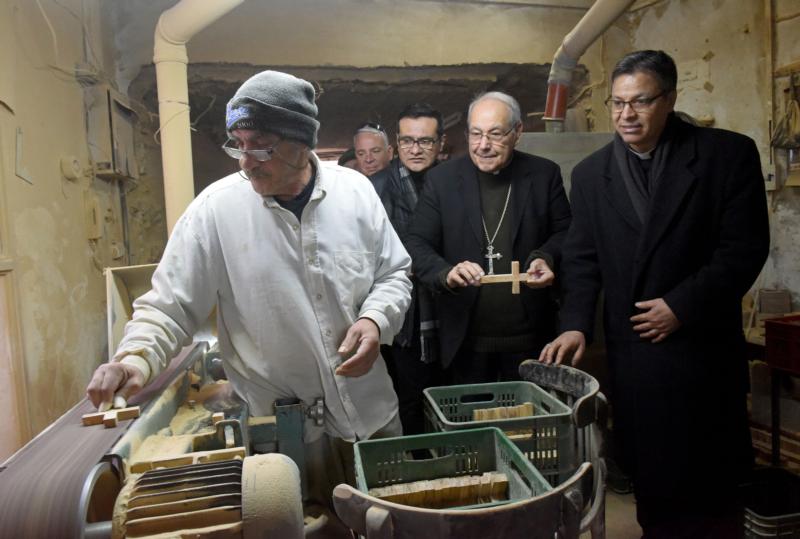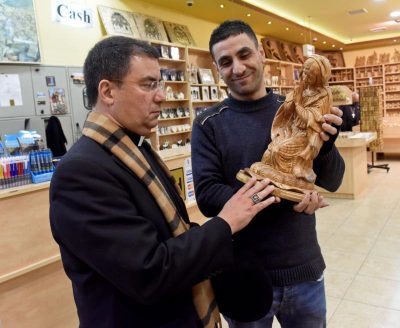
Bishop Felipe de Jesus Estevez of St. Augustine, Fla., holding cross, and Auxiliary Bishop Alberto Rojas of Chicago, right, watch a Palestinian worker make crosses made of olive wood Jan. 27 at the Holy Land Handicraft Cooperative Society in Beit Sahour, West Bank. (CNS photo/Debbie Hill)
BEIT SAHOUR, West Bank (CNS) — Retired Bishop Placido Rodriguez of Lubbock, Texas, remembers the smell of woodworking and the feel of wood in his hands from when he was a child in his family furniture factory in Celaya, Mexico.
“Here they are working with olive wood; in Mexico we worked with cedar. We see the connection with our brothers here,” Bishop Rodriguez said as he walked through the small family-run Odeh Factory, which produces traditional olive wood statues and souvenirs to sell to pilgrims and tourists. “I see the effort that is needed, and the talent, (to do this work) as a way to support and feed their families. I can see this is the work of Christians. I don’t have to be told that, you can see it in their work.”
Bishop Rodriguez was among 10 bishops who participated in the Jan. 18-27 USCCB Hispanic Bishops’ Pilgrimage for Peace in the Holy Land. They met with local Christians as well as with other Palestinians and Israelis to get a firsthand understanding of the situation and to advocate for “bridges not walls.” Many bishops said the pilgrimage gave them a better understanding of the Palestinian Christian reality in the Holy Land and gave them the opportunity to express their solidarity with the community, which makes up less than 2 percent of the Palestinian population.
[hotblock]
On Jan. 27, Catholic Relief Services hosted the bishops in the traditionally Christian village of Beit Sahour, near Bethlehem, for a tour of the CRS Fair Trade Partner Holy Land Handicraft Cooperative Society, and a visit to one of the artisan workshops CRS recently helped renovate to improve working conditions.
“It has given me a special understanding of the reason why the number of Christians in the Holy Land is decreasing and the difficulty of living here because of the occupation,” said Bishop Felipe de Jesus Estevez of St. Augustine, Florida. “While I have felt a great sadness at their situation, I have also marveled at the resilience of the Holy Family Parish in Gaza.”
Bishop Nelson J. Perez of Cleveland described Gaza with its 2.3 million people as a “virtual human prison,” where residents cannot leave and others cannot enter. While there is a political aspect to the situation, the humanitarian side of it cannot be ignored, he said.
“People have the right to freedom of movement, right to life. I would hope that somehow, someday this will get resolved,” he said. “Both the Israelis and the Palestinians have their narrative, but (the situation must be dealt with) in a way which respects the dignity of the human person.”
He said although the students of Bethlehem University with whom they spoke gave him hope as they expressed desire for peace, their prospects for gainful employment were minimal, and many young Christian Palestinians emigrate because of lack of work.

Bishop Oscar Cantu of Las Cruces, N.M., touches a statue of Mary Jan. 27 made out of olive wood at the Holy Land Handicraft Cooperative Society in Beit Sahour, West Bank. (CNS photo/Debbie Hill)
“We can’t judge one side over the other but … justice and peace must reign between these two communities living here,” said Auxiliary Bishop Alberto Rojas of Chicago. “This is possible only if each one recognizes the dignity of the other.”
“We have been exposed more to the reality of life here and have heard … of the fear of Israelis near the Gaza border,” said Bishop Perez. “I could relate to the fear of being shot at. People have died. That was as disturbing as seeing the limitation of movement of people from Gaza.”
“There have been situations in the world where, in their moments, people felt there was no hope and there was nothing to be done,” he added. “But history has shown through God’s grace and intervention and goodness of people situations have changed.”
PREVIOUS: In times of trouble, turn to Mary, pope says at St. Mary Major Basilica
NEXT: Failures offer opportunity to improve protection efforts, expert says



Share this story